|
|
|
Sort Order |
|
|
|
Items / Page
|
|
|
|
|
|
|
| Srl | Item |
| 1 |
ID:
173837
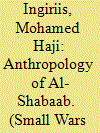

|
|
|
|
|
| Summary/Abstract |
Harakaat Al-Shabaab Al-Mujaahiduun (henceforth Al-Shabaab) is an active insurgent group in southern Somalia battling against the foreign forces and foreign-backed Somali forces. Despite recruiting both in Somalia and in the diaspora, this insurgency movement continues to increasingly recruit more local Somali youth than diaspora Somalis or non-Somalis. This article suggests that Al-Shabaab solicits support from diverse youth who – due to a confluence of factors – join the insurgency movement in various ways. The article reveals how the movement’s methods are flexible insofar as it skilfully recruits both powerful clans and marginalised clans. This pattern tests the limits of the Somali federal government in Mogadishu who have yet to develop innovative approaches to challenge and contain Al-Shabaab. The government failure not only allows Al-Shabaab to successfully carry out its operations but also to sustain itself in the midst of local communities. Through interviews with former Al-Shabaab youth, the article explores youth recruiting efforts and finds that the militant movement pursues various sophisticated means to lure numerous youth into its ranks.
|
|
|
|
|
|
|
|
|
|
|
|
|
|
|
|
| 2 |
ID:
160733
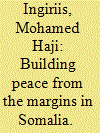

|
|
|
|
|
| Summary/Abstract |
The prevailing discourse in Mogadishu among the federal government of Somalia and the international community is that Al-Shabaab is no longer relevant in contemporary Somali political landscape. In the language of the government, Al-Shabaab is like a lost crocodile thrown out from the river. In the lexicon of the international community, Al-Shabaab is gradually receding. In fact, Al-Shabaab is actually puissant and potent in terms of social, political and military capabilities; not just in Somalia, but also in the wider East Africa region. Why is Al-Shabaab resilient and resistant? Why is it even more effective than the federal government? To answer these questions, this article reveals how Al-Shabaab is increasingly more legitimate than the federal government. In conclusion, the article proposes that negotiated settlement with the insurgency movement could lead to peace in war-torn southern Somalia.
|
|
|
|
|
|
|
|
|
|
|
|
|
|
|
|
| 3 |
ID:
163699
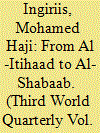

|
|
|
|
|
| Summary/Abstract |
External intervention has frustrated and continues to frustrate peace and stability in the Horn of Africa and Somalia, adding various adverse layers to an already complicated and complex conflict. The level of forceful military engagement intended for regional domination has profoundly affected negatively the efforts of peacebuilding and statebuilding in Somalia. This article examines how the earlier Ethiopian policies towards Somalia has reshaped the (post)-Cold War politics of the Horn. In doing so, it traces the roots of the Ethiopian intervention in Somalia vis-à-vis new non-state armed groups to chart the changing political dynamics of the conflict in Somalia. By using historical approach, the article argues that Ethiopia’s agenda is central to understanding why the ‘War on Terror’ has strengthened and subsequently midwifed armed militant movements (e.g. new insurgency groups) in Somalia, starting from Al-Itihaad to today’s Al-Shabaab. In focusing upon various regional actors and groups, the article moves from the emphasis of internal systems to external power structures, considering the wider historical and political factors in the region that must be closely examined if the regional and local conflicts are to be deeply understood. While it is a context-specific study, the article aims to contribute fresh perspectives and insights to ongoing discussions on the consequences of the Ethiopian intervention in Somalia.
|
|
|
|
|
|
|
|
|
|
|
|
|
|
|
|
| 4 |
ID:
173192
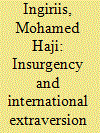

|
|
|
|
|
| Summary/Abstract |
This article examines the various deficiencies of the security agency of the Federal Government of Somalia in Mogadishu in terms of intelligence capacity, capability and competence to counter Harakaat Al-Shabaab Al-Mujaahiduun (hereafter Al-Shabaab), the militant movement fighting against the government and its external backers. Based on field-based oral and written research data in Mogadishu, the article argues that the heavy dependence of the government's National Intelligence and Security Agency (NISA) on various external patrons essentially makes the agency less efficient and effective than Al-Shabaab's intelligence agency, the Amniyat. Looking at the internal dynamics of the government and its rival insurgency movement offers fresh anthropological insights into how the Amniyat is more dynamic than the government's intelligence agency. In spite of its internal faults and failures, the Federal Government has become stuck in an externally-imposed security architecture envisioned by the so-called ‘partners’. This has made the NISA far behind the Amniyat in terms of security provision because both opposing security agencies pursue different methods to broadcast their power and presence. Delving deeper into the inner workings of the security institutions of the NISA and the Amniyat demonstrates that the performances and practices of the two intelligence agencies reflect the acute failure that inherently characterises the government security sector.
|
|
|
|
|
|
|
|
|
|
|
|
|
|
|
|
| 5 |
ID:
159209
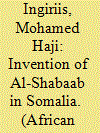

|
|
|
|
|
| Summary/Abstract |
Despite the growing body of academic literature that seeks to explain the evolution of Al-Shabaab, the movement remains one of the least understood on the continent. This article explores the relationship between the militant movement and the twentieth-century anti-colonial Somali insurgency movement of the Dervishes, examining the extent to which Al-Shabaab imitates the Dervishes. It argues that Al-Shabaab is not unique when considered as a contemporary re-incarnation of the Dervishes. Approaching Al-Shabaab as a heterogeneous insurgency movement established and sustained by emulation, the article compares Al-Shabaab to the Dervishes in terms of their leadership characteristics, war strategies and ideological foundations. In doing so, it uses interviews and focus group discussions carried out in Mogadishu and Afgooye (Somalia) as well as a variety of under-explored sources such as visual data. It concludes that Al-Shabaab draws directly and indirectly from the Dervishes in crucial ways, but that there are also differences between the two movements in terms of mobilization and utilizing political and cultural dynamics.
|
|
|
|
|
|
|
|
|
|
|
|
|
|
|
|
| 6 |
ID:
172580
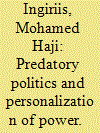

|
|
|
|
|
| Summary/Abstract |
This article investigates the security sector in Somalia, with a focus on the National Intelligence and Security Agency (NISA), a government security unit, involved in the fight against the Al-Shabaab insurgency. This article argues that the historically traumatic legacy of autocratic oppression of the former military regime gives the Somali intelligence agency an infamous reputation that survives today and plays a significant role in the operations of the intelligence agency. Intelligence agents employ tactics from the late Cold War era military regime’s intelligence services, suggesting striking historical continuities of the military regime in practice and performance. The empirical data also shows that NISA is enmeshed in the ‘dirty war’ between the federal government and Al-Shabaab. Not only does the intelligence agency normalize extrajudicial activities to serve the agenda of political authorities and to suppress their critics, but it also financially benefits from arrests without trials. NISA agents harass the public and political opposition groups daily and brutally suppress mass media and freedom of speech, especially in the government-controlled areas in Mogadishu. As the first empirical academic investigation into NISA, the article contributes to broader debates on intelligence, the anthropology of the state, security studies, and institution- and state-building in violent environments.
|
|
|
|
|
|
|
|
|
|
|
|
|
|
|
|
|
|
|
|
|